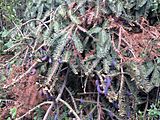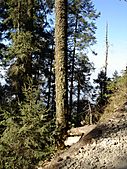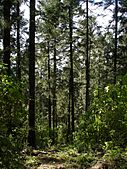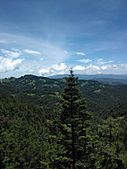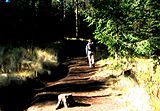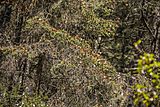Oyamel fir facts for kids
Quick facts for kids Oyamel fir |
|
|---|---|
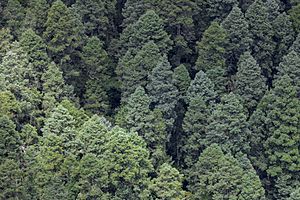 |
|
| Sacred fir forest at El Chico National Park in Hidalgo, Mexico | |
| Conservation status | |
| Scientific classification | |
| Genus: |
Abies
|
| Species: |
religiosa
|
| Synonyms | |
|
|
The oyamel fir, also known as the sacred fir (Abies religiosa), is a special type of fir tree. In Spanish, it's called oyamel. These trees grow naturally in the mountains of central and southern Mexico and western Guatemala.
You can find sacred firs high up in the mountains. They prefer altitudes from about 6,900 to 13,500 feet (2,100 to 4,100 meters). They thrive in cloud forests, which are cool and humid in summer. Winters are usually dry in most places where they grow. However, in the state of Veracruz, they get rain all year. These trees are strong and can handle regular winter snow.
Contents
What's in a Name?
The Spanish name oyamel comes from an old language called Nahuatl. The word oyametl means "threshing agave."
In Mexico, people sometimes call this tree árbol de Navidad, which means "Christmas tree." The English name "sacred fir" comes from its scientific name, Abies religiosa. "Religiosa" means "religious" in Latin. This name was given because people in Mexico use its branches in religious celebrations, especially at Christmas, and to decorate churches.
What Does the Sacred Fir Look Like?
The sacred fir is a medium to large evergreen coniferous tree. This means it keeps its needles all year round. It can grow very tall, from about 80 to 160 feet (25 to 50 meters). Its trunk can become quite wide, up to 6.5 feet (2 meters) across.
Leaves and Needles
The leaves of the sacred fir are like needles. They are flat and measure about 0.6 to 1.4 inches (1.5 to 3.5 centimeters) long. They are dark green on top. If you look underneath, you'll see two blue-white stripes. These stripes are made of tiny openings called stomata, which help the tree breathe. The tip of each needle is pointed.
The needles grow in a spiral pattern around the branch. However, each needle twists at its base. This makes them lie flat on either side of the branch, with none growing directly underneath. The young branches are reddish-brown and can be smooth or have a few tiny hairs.
Cones and Seeds
The cones of the sacred fir are quite large. They are about 3 to 6 inches (8 to 16 centimeters) long and 1.5 to 2.5 inches (4 to 6 centimeters) wide. Before they are fully grown, they are a dark blue-purple color.
The cones have scales that are purple or greenish. When the cone is closed, you can see the tips of these scales sticking out. The cones release their winged seeds when they break apart. This happens about 7 to 9 months after the tree is pollinated. Some sacred firs from western Mexico have cones with larger, bent-back scales. These are sometimes considered a different type of fir.
Why is the Sacred Fir Important?
The sacred fir is very important for the monarch butterfly (Danaus plexippus). These trees are the favorite place for monarch butterflies to spend the winter. Millions of monarch butterflies travel a long way from Canada and the United States to hibernate in these fir forests.
Monarch Butterfly Home
Most monarch butterflies gather in a few special fir forests. These forests are protected in the Monarch Butterfly Biosphere Reserve. This reserve is near towns like Angangueo in Michoacán and Avándaro in the State of Mexico. The butterflies stay there from December to March. It's an amazing sight to see so many butterflies covering the trees!
Uses and Challenges
The wood from the sacred fir is quite soft. This means it's not the best for building or making furniture. Sadly, the number of sacred fir trees is decreasing. This is partly because people cut them down for firewood. Other human activities also disturb their natural habitat.
Scientists have studied the future of the sacred fir. A 2012 study suggested that the areas suitable for the oyamel fir might shrink a lot by 2090. This could mean the trees might even disappear completely from the Monarch Butterfly Biosphere Reserve. This is why protecting these forests is so important.
Gallery
-
Chincua sanctuary, the Monarch Butterfly Biosphere Reserve
-
El Rosario sanctuary, the Monarch Butterfly Biosphere Reserve
-
In the Sierra Norte, Oaxaca
-
Firs and zacatonal plant community on the trail of La Malinche, Tlaxcala
See also
 In Spanish: Oyamel para niños
In Spanish: Oyamel para niños



